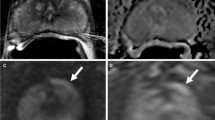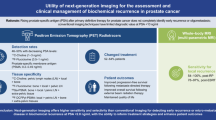Abstract
Purpose
To discuss the potential utility of newer imaging modalities including micro-ultrasound and PSMA-PET for the detection of clinically significant prostate cancer, technologies that may gain roles as adjuncts to multiparametric magnetic resonance imaging (mpMRI) in the active surveillance (AS) setting.
Methods
Narrative review of two new imaging modalities used for primary prostate cancer through April 2021. A targeted search was performed to identify current relevant literature on the role of new imaging modalities for primary prostate cancer using search terms “micro-ultrasound,” “molecular imaging,” “prostate cancer,” “active surveillance,” “multiparametric MRI,” “PI-RADS,” “PRI-MUS,” and “detection rate.” In addition, references of included articles were screened for further relevant publications.
Results
Micro-ultrasound (micro-US) and prostate-specific membrane antigen-positron emission tomography (PSMA-PET) are increasing in their use and applicability to prostate cancer imaging. Micro-US is used for cancer detection and may identify higher grade cancers more accurately than conventional ultrasound, despite technical hurdles in its initial launch. PSMA-PET is highly sensitive and specific for high-grade and metastatic prostate cancer, though costly and not easily available. Though data are sparse, it may have an emerging role in cancer diagnosis in select localized cases, and in some men considering (or currently on) AS who have indications of more aggressive disease.
Conclusion
There are very limited data on micro-US and PSMA-PET in AS patients. However, given the ability of these modalities to identify high-grade cancer, their judicious use in AS patients may be of utility in the future.


Similar content being viewed by others
Availability of data and materials
Not applicable.
References
Siegel RL, Miller KD, Fuchs HE, Jemal A (2021) Cancer Statistics, 2021. CA Cancer J Clin 71(1):7–33. https://doi.org/10.3322/caac.21654
Rouvière O, Puech P, Renard-Penna R, et al. Use of prostate systematic and targeted biopsy on the basis of multiparametric MRI in biopsy-naive patients (MRI-FIRST): a prospective, multicentre, paired diagnostic study. www.thelancet.com/oncology. 2019;20. doi:https://doi.org/10.1016/S1470-2045(18)30569-2
Ahmed HU, El-Shater Bosaily A, Brown LC et al (2017) Diagnostic accuracy of multi-parametric MRI and TRUS biopsy in prostate cancer (PROMIS): a paired validating confirmatory study. Lancet 389(10071):815–822. https://doi.org/10.1016/S0140-6736(16)32401-1
Kasivisvanathan V, Rannikko AS, Borghi M et al (2018) MRI-targeted or standard biopsy for prostate-cancer diagnosis. N Engl J Med 378(19):1767–1777. https://doi.org/10.1056/NEJMoa1801993
Sarkar D. The role of multi-parametric MRI and fusion biopsy for the diagnosis of prostate cancer–A systematic review of current literature. In: Advances in Experimental Medicine and Biology. Vol 1095. Springer New York LLC; 2018:111–123. doi:https://doi.org/10.1007/978-3-319-95693-0_7
O’Connor LP, Lebastchi AH, Horuz R et al (2020) Role of multiparametric prostate MRI in the management of prostate cancer. World J Urol Published online. https://doi.org/10.1007/s00345-020-03310-z
Borofsky S, George AK, Gaur S et al (2018) What are we missing? False- negative cancers at multiparametric MR imaging of the prostate. Radiology 286(1):186–195. https://doi.org/10.1148/radiol.2017152877
Rosenkrantz AB, Verma S, Choyke P et al (2016) Prostate magnetic resonance imaging and magnetic resonance imaging targeted biopsy in patients with a prior negative biopsy: a consensus statement by AUA and SAR. J Urol 196(6):1613–1618. https://doi.org/10.1016/j.juro.2016.06.079
Rosenkrantz AB, Ginocchio LA, Cornfeld D et al (2016) Interobserver reproducibility of the PI-RADS version 2 lexicon: A multicenter study of six experienced prostate radiologists. Radiology 280(3):793–804. https://doi.org/10.1148/radiol.2016152542
Chen RC, Bryan Rumble R, Andrew Loblaw D et al (2016) Active surveillance for the management of localized prostate cancer (Cancer Care Ontario guideline): American society of clinical oncology clinical practice guideline endorsement. J Clin Oncol 34(18):2182–2190. https://doi.org/10.1200/JCO.2015.65.7759
Pavlovich CP, Cornish TC, Mullins JK et al (2014) High-resolution transrectal ultrasound: Pilot study of a novel technique for imaging clinically localized prostate cancer. Urol Oncol Semin Orig Investig 32(1):34.e27-34.e32. https://doi.org/10.1016/j.urolonc.2013.01.006
Pavlovich CP, Hyndman ME, Eure G, et al. A multi‐institutional randomized controlled trial comparing first‐generation transrectal high‐resolution micro‐ultrasound with conventional frequency transrectal ultrasound for prostate biopsy. BJUI Compass. Published online November 28, 2020:bco2.59. doi:https://doi.org/10.1002/bco2.59
Ghai S, Eure G, Fradet V et al (2016) Assessing cancer risk on novel 29 MHz micro-ultrasound images of the prostate: creation of the micro-ultrasound protocol for prostate risk identification. J Urol 196(2):562–569. https://doi.org/10.1016/j.juro.2015.12.093
Klotz L, Lughezzani G, Maffei D et al (2020) Comparison of micro-ultrasound and multiparametric magnetic resonance imaging for prostate cancer: A multicenter, prospective analysis. Can Urol Assoc J. https://doi.org/10.5489/cuaj.6712
Lughezzani G, Maffei D, Saita A et al (2020) Diagnostic accuracy of microultrasound in patients with a suspicion of prostate cancer at magnetic resonance imaging: A Single-institutional Prospective Study. Eur Urol Focus. https://doi.org/10.1016/j.euf.2020.09.013
Eure G, Fanney D, Lin J, Wodlinger B, Ghai S (2019) Comparison of conventional transrectal ultrasound, magnetic resonance imaging, and micro-ultrasound for visualizing prostate cancer in an active surveillance population: A feasibility study. Can Urol Assoc J 13(3):E70–E77. https://doi.org/10.5489/cuaj.5361
Wiemer L, Hollenbach M, Heckmann R et al (2020) Evolution of targeted prostate biopsy by adding micro-ultrasound to the magnetic resonance imaging pathway. Published online. https://doi.org/10.1016/j.euf.2020.06.022
Ma TM, Tosoian JJ, Schaeffer EM et al (2017) The role of multiparametric magnetic resonance imaging/ultrasound fusion biopsy in active surveillance. Eur Urol 71(2):174–180. https://doi.org/10.1016/j.eururo.2016.05.021
Claros OR, Tourinho-Barbosa RR, Fregeville A et al (2020) Comparison of initial experience with transrectal magnetic resonance imaging cognitive guided micro-ultrasound biopsies versus established transperineal robotic ultrasound magnetic resonance imaging fusion biopsies for prostate cancer. J Urol 203(5):918–925. https://doi.org/10.1097/JU.0000000000000692
Cornud F, Lefevre A, Flam T et al (2020) MRI-directed high-frequency (29MhZ) TRUS-guided biopsies: initial results of a single-center study. Eur Radiol. https://doi.org/10.1007/s00330-020-06882-x
Eric Hyndman M, Pavlovich CP, Eure G, Beach V, Fradet V, Ghai S. prospective validation of pri-mus™, the prostate risk identification using micro-ultrasound protocol for real-time detection of prostate cancer using high-resolution micro-ultrasound imaging. Vol 199.; 2018. doi:https://doi.org/10.1016/j.juro.2018.02.1741
Wang B, Liu C, Wei Y et al (2020) A prospective trial of 68Ga-PSMA and 18F-FDG PET/CT in nonmetastatic prostate cancer patients with an early PSA progression during castration. Clin Cancer Res 26(17):4551–4558. https://doi.org/10.1158/1078-0432.CCR-20-0587
Kim S-J, Lee SW. The role of 18 F-fluciclovine PET in the management of prostate cancer: a systematic review and meta-analysis. doi:https://doi.org/10.1016/j.crad.2019.06.022
Turkbey B, Mena E, Shih J et al (2014) Localized prostate cancer detection with 18F FACBC PET/CT: Comparison with MR imaging and histopathologic analysis. Radiology 270(3):849–856. https://doi.org/10.1148/radiol.13130240
Schuster DM, Taleghani PA, Nieh PT, et al. Characterization of primary prostate carcinoma by anti-1-amino-2-[(18)F] -fluorocyclobutane-1-carboxylic acid (anti-3-[(18)F] FACBC) uptake. Am J Nucl Med Mol Imaging. 2013;3(1):85–96. Accessed December 28, 2020. http://www.ncbi.nlm.nih.gov/pubmed/23342303
Elschot M, Selnaes KM, Sandsmark E et al (2018) Combined 18 F-fluciclovine PET/MRI shows potential for detection and characterization of high-risk prostate cancer. J Nucl Med 59:762–768. https://doi.org/10.2967/jnumed.117.198598
Hofman MS, Lawrentschuk N, Francis RJ et al (2020) Prostate-specific membrane antigen PET-CT in patients with high-risk prostate cancer before curative-intent surgery or radiotherapy (proPSMA): a prospective, randomised, multicentre study. Lancet 395(10231):1208–1216. https://doi.org/10.1016/S0140-6736(20)30314-7
Hope TA, Armstrong WR, Murthy V et al (2020) Accuracy of 68Ga-PSMA-11 for pelvic nodal metastasis detection prior to radical prostatectomy and pelvic lymph node dissection: A multicenter prospective phase III imaging study. J Clin Oncol 38((15_suppl)):5502–5502. https://doi.org/10.1200/jco.2020.38.15_suppl.5502
Miller ET, Salmasi A, Reiter RE. Anatomic and molecular imaging in prostate cancer. Cold Spring Harb Perspect Med. 2018;8(3). doi:https://doi.org/10.1101/cshperspect.ă19
Oh SW, Cheon GJ (2018) Prostate-specific membrane antigen PET imaging in prostate cancer: Opportunities and challenges. Korean J Radiol 19(5):819–831. https://doi.org/10.3348/kjr.2018.19.5.819
Bjurlin MA, Carter HB, Schellhammer P et al (2013) Optimization of initial prostate biopsy in clinical practice: Sampling, labeling and specimen processing. J Urol 189(6):2039–2046. https://doi.org/10.1016/j.juro.2013.02.072
Rahbar K, Weckesser M, Huss S et al (2016) Correlation of intraprostatic tumor extent with 68Ga-PSMA distribution in patients with prostate cancer. J Nucl Med 57(4):563–567. https://doi.org/10.2967/jnumed.115.169243
Eiber M, Weirich G, Holzapfel K, et al. Simultaneous 68 Ga-PSMA HBED-CC PET/MRI Improves the Localization of Primary Prostate Cancer. doi:https://doi.org/10.1016/j.eururo.2015.12.053
Hicks RM, Simko JP, Westphalen AC et al (2018) Diagnostic accuracy of 68 Ga-PSMA-11 PET/MRI compared with multiparametric mri in the detection of prostate cancer. Radiology 289(3):730–737. https://doi.org/10.1148/radiol.2018180788
Rhee H, Thomas P, Shepherd B et al (2016) Prostate specific membrane antigen positron emission tomography may improve the diagnostic accuracy of multiparametric magnetic resonance imaging in localized prostate cancer. J Urol 196(4):1261–1267. https://doi.org/10.1016/j.juro.2016.02.3000
Meyer AR, Joice GA, Allaf ME, Rowe SP, Gorin MA (2018) Integration of PSMA-targeted PET imaging into the armamentarium for detecting clinically significant prostate cancer. Curr Opin Urol 28(6):493–498. https://doi.org/10.1097/MOU.0000000000000549
Study of PSMA-targeted 18F-DCFPyL PET/CT for the Detection of Clinically Significant Prostate Cancer - Full Text View - ClinicalTrials.gov. Accessed January 17, 2021. https://clinicaltrials.gov/ct2/show/NCT03471650
Rowe SP, Gage KL, Faraj SF et al (2015) 18F-DCFBC PET/CT for PSMA-based detection and characterization of primary prostate cancer. J Nucl Med 56(7):1003–1010. https://doi.org/10.2967/jnumed.115.154336
Gorin MA, Rowe SP, Patel HD et al (2018) Prostate specific membrane antigen targeted 18F-DCFPyL positron emission tomography/computerized tomography for the preoperative staging of high risk prostate cancer: results of a prospective, phase II. Single Center Study J Urol 199(1):126–132. https://doi.org/10.1016/j.juro.2017.07.070
Simopoulos DN, Natarajan S, Jones TA, Fendler WP, Sisk AE, Marks LS (2017) Targeted prostate biopsy using 68Gallium PSMA-PET/CT for image guidance. Urol Case Reports 14:11–14. https://doi.org/10.1016/j.eucr.2017.05.006
Kasperzyk JL, Finn SP, Flavin R et al (2013) Prostate-specific membrane antigen protein expression in tumor tissue and risk of lethal prostate cancer. Cancer Epidemiol Biomarkers Prev 22(12):2354–2363. https://doi.org/10.1158/1055-9965.EPI-13-0668
RE Feria Cardet De MS Hofman T Segard et al 2020 Is prostate-specific membrane antigen positron emission tomography/computed tomography imaging cost-effective in prostate cancer: an analysis informed by the propsma trial Published online https://doi.org/10.1016/j.eururo.2020.11.043
Sountoulides P, Pyrgidis N, Polyzos SA et al (2021) Micro-ultrasound–guided vs multiparametric magnetic resonance imaging-targeted biopsy in the detection of prostate cancer: a systematic review and meta-analysis. J Urol 205(5):1254–1262. https://doi.org/10.1097/ju.0000000000001639
Lopci E, Lughezzani G, Castello A et al (2021) PSMA-PET and micro-ultrasound potential in the diagnostic pathway of prostate cancer. Clin Transl Oncol 23(1):172–178. https://doi.org/10.1007/s12094-020-02384-w
Funding
Not applicable.
Author information
Authors and Affiliations
Contributions
All authors contributed to the conception and overall writing of this work.
Corresponding author
Ethics declarations
Conflict of interests
Steven P. Rowe receives research funding and serves as a Consultant to Progenics Pharmaceuticals, Inc., the licensee of 18F-DCFPyl.
Additional information
Publisher's Note
Springer Nature remains neutral with regard to jurisdictional claims in published maps and institutional affiliations.
Rights and permissions
About this article
Cite this article
Bhanji, Y., Rowe, S.P. & Pavlovich, C.P. New imaging modalities to consider for men with prostate cancer on active surveillance. World J Urol 40, 51–59 (2022). https://doi.org/10.1007/s00345-021-03762-x
Received:
Accepted:
Published:
Issue Date:
DOI: https://doi.org/10.1007/s00345-021-03762-x




